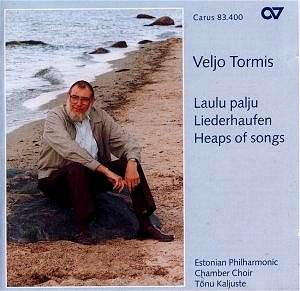It is more than mere coincidence that Carus-Verlag
of Stuttgart are also the publishers of the printed music for the choral
works of the distinguished composer Veljo Tormis. Choral competitions
both international and state-bound are still a vital activity around
the world and the appetite for fresh repertoire remains largely unslaked.
Tormis, quite apart from responding to his innate sympathy with a gift
for choral writing, feeds this interest. His music can be fitted into
the grand tradition of Scandinavian and Baltic choirs. That tradition
is vigorous and poetic fed by composers such as Alfvén, Palmgren,
Sibelius, Darzins and Ivanovs.
Tönu Kaljuste's choir is fully into the idiom
with acres of fierce muscular tone as well as otherworldly sweetness
and hollow ochre-brown resonance. Listen for example to Kuhjaloola
(The Haystack Builder in track 25) - typically one of a set
of harvest work songs. Many of these have that character almost a capstan
sea-chanty similar to the sound of the Gaelic waulking song. Before
reading the helpful feature by Urve Lippus I had noted the similarity
between these choral songs and the a cappella works of Kodaly.
I am familiar with the Kodaly pieces from a series broadcast by BBC Radio
3 in 1981 and 1982. Kodaly even wrote one song based on a Finnish Kalevala
episode involving Vainamoinen. Tormis was deeply impressed with the
Kodaly pieces when attending the Hungarian festivities in 1962 to mark
the 80th birthday.
Tormisís music is variously: roundedly melodic, warmly
cocooned, violently tuneful, often using unison in thunderous affirmation,
evocative of spirituals, primitive-ecstatic and lyrical. Apart from
the Kodaly echoes we may occasionally think of Michael Nyman's wedding
songs in Prospero's Books or of the ululating exultant confidence
of Christopher Brown's Hodie salvator apparuit or Rosenberg's
dizzying paeans of praise at the end of his Fourth Symphony. Howellsians
would be likely to find reward in this singing. Highlights are numerous.
One song suggests a familiarity with Rachmaninov's Chrysostum another
picks up on the gentle rocking breath of En Saga. The Work Songs
are bronzed and strong and the ecstatic calls of hoi tara voi tara
are wonderfully memorable. In others (trs 9; 10; 12) refrains like
ollale ollale, kosjad oleme and ellero ellero are
catchy and likely to win immediate and long-term friends.
Now I have heard this choir I urge them to tackle Arnold
Bax's choral chef d'oeuvre, Mater Ora Filium, Poulenc's La
Figure Humaine and Strauss's Eine Deutsches Motette. Here
is a choir fully the equal of these testing works. They have a majestic
mastery which includes the requisite power, range and flexibility. For
now the choir can be heard in Carus's CDs of the Mozart Vesperae
et Litaniae (83.401 and 83.402) as well as two Carus volumes of
Vivaldi's sacred music (83.403 and 83.404)
Although known the world over as a choral composer
this pupil of Vissarion Shebalin has also tackled more complex works
such as the Estonian Ballads for soloists, choir and orchestra
(1980) and the oratorio The Rite of Birth for three choirs and
orchestra (1999). Hearing these works has to be one of this listener's
high priorities.
I shall be disappointed if the next televised choral
competition includes a choir that fails to present a work by Tormis.
Rob Barnett
